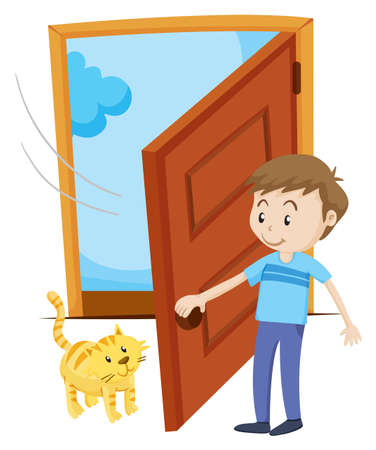Understanding Your Pet’s Needs and Behaviors
Before you start pet-proofing your bedroom, it’s essential to take a step back and really get to know your furry, feathery, or scaly roommate. Every pet—from the bounciest puppy to the laziest housecat or even an adventurous ferret—brings their own unique habits and quirks into your space. By observing how your pet behaves, you’ll be able to anticipate potential trouble spots and create a bedroom that’s both safe and comforting for everyone.
For example, cats are natural climbers and love to perch on high shelves or window sills. Dogs may have a knack for sniffing out anything that smells interesting (including your socks under the bed). Small critters like rabbits or guinea pigs tend to chew on wires or furniture legs, while birds might be attracted to shiny objects or loose threads. Each of these behaviors tells you where you’ll need to pay extra attention when making your bedroom pet-friendly.
Spend some time noticing where your pet likes to sleep, play, or hide. Are there certain corners they gravitate towards? Do they seek out cozy blankets or cool tile floors? Understanding these preferences will help you set up comfortable resting spots and redirect them away from areas that could pose a risk. The goal is to balance safety with comfort so both you and your pet can enjoy your shared haven without worry.
Securing Hazardous Items and Spaces
Our bedrooms are meant to be cozy retreats, but for pets with curious paws and twitching noses, they can also become a playground filled with hidden dangers. Making your bedroom pet-proof isn’t just about comfort—it’s about safety. Let’s look at some practical tips for identifying and stowing away potential hazards, from loose cords to toxic plants, ensuring your furry companions stay out of trouble.
Spotting Common Hazards in the Bedroom
Start by getting down to your pet’s level—literally! Crawling around on the floor gives you a new perspective and helps you spot things that might attract a playful kitten or a nosy pup. Here are some common culprits to watch out for:
| Hazard | Why Its Dangerous | How to Secure |
|---|---|---|
| Loose Cords (blinds, chargers) | Risk of strangulation or electrocution if chewed | Use cord covers, wind cords up high, unplug devices when not in use |
| Small Objects (earrings, hair ties) | Choking hazard or intestinal blockage if swallowed | Keep in closed containers or drawers |
| Toxic Plants (like lilies, pothos) | Can cause vomiting, organ failure, or worse if ingested | Remove from room or replace with pet-safe varieties |
| Pill Bottles & Medications | Easily knocked over; many meds are toxic to pets | Store in high cabinets with secure lids |
| Scented Candles & Essential Oils | Certain scents and oils are harmful to cats and dogs | Avoid use in pet areas or choose pet-safe products only |
Tidy Up: Simple Storage Solutions
If you’re anything like me—a fan of cozy corners and little knickknacks—your bedroom might have more stuff than you realize. Invest in baskets with lids, organizers that fit under the bed, and sturdy nightstand drawers. These not only keep your treasures safe but also prevent pets from finding things they shouldn’t.
Cord Control Tricks
Cats love to bat at dangling blind cords, while pups may chew on phone chargers. Try wrapping excess cords in spiral cable wraps, using adhesive hooks to lift them off the ground, or installing cordless window treatments for extra peace of mind.
A Quick Room Checklist:
- Check under the bed and behind furniture for stray items.
- Secure trash cans with tight-fitting lids.
- Remove breakables from low tables where tails can swipe them off.
- Label any houseplants as “pet-safe” or “not for pets.”
- Close closet doors to keep shoes and laundry out of reach.
Taking these steps means you can relax and enjoy snuggle time in your sanctuary, knowing both you and your pets are protected from unexpected mishaps. A safe bedroom is a happy bedroom—for every member of the family!
![]()
3. Pet-Friendly Bedding and Furniture Choices
When it comes to pet-proofing your bedroom, choosing the right bedding and furniture is a game changer. Our furry family members love to snuggle with us, but they can be tough on fabrics and surfaces—think fur, claws, drool, and the occasional muddy paw print after a romp in the yard.
Durable Materials That Stand Up to Pets
Upholstery
Opt for tightly woven fabrics like microfiber, canvas, or leather (real or faux). Microfiber is especially popular because it resists tears from claws, doesn’t trap hair easily, and wipes clean with minimal effort. Leather also cleans up quickly, though it can show scratches—some pet parents embrace this as “character,” while others use slipcovers for extra protection.
Bedding
Go for machine-washable cotton or linen duvet covers and sheets. Avoid delicate materials like silk or velvet that attract fur and are hard to launder. Consider darker colors or patterns that camouflage fur between washes—it’s a lifesaver during shedding season!
Easy-to-Clean Furniture Solutions
If you allow pets on the bed or bedroom chairs (let’s be honest, they usually find their way there), invest in washable throws or furniture protectors. These can be tossed in the laundry after muddy adventures at the dog park or during rainy spring days. Many American homes also use removable slipcovers for upholstered beds and headboards; they’re practical and make seasonal redecorating a breeze.
Keeping Things Cozy
Practical doesn’t mean sacrificing comfort! Layer your bed with plush blankets that are easy to wash, add soft area rugs that are stain-resistant (like indoor/outdoor rugs), and don’t forget a dedicated pet bed so your furry friend has their own comfy spot. This way, everyone gets to enjoy that warm, welcoming farmhouse vibe—even when paws are less than pristine.
Pro Tip:
A lint roller on your nightstand is your best friend for quick de-furring before guests arrive—or before you crawl into bed for some well-earned rest after a busy day on the homestead.
4. Setting Up Designated Pet Zones
Creating a bedroom that’s both stylish and pet-friendly starts with setting up designated zones for your furry, scaly, or feathery companion. By giving your pet their own cozy spaces, you help prevent them from claiming your entire room while ensuring they feel right at home. Here are some ideas to inspire your pet-proofed sanctuary:
Comfy Beds for Every Kind of Pet
| Pet Type | Bed Ideas | Location Tips |
|---|---|---|
| Dog/Cat | Memory foam bed, donut cuddler, heated pad | Near your bed but out of the main walkway |
| Small Animals (Rabbits, Guinea Pigs) | Soft fleece mat, hideaway hutches | Corner nook away from drafts and noise |
| Birds | Cage with cozy nest box, rope perches | By a window (but avoid direct sunlight) |
| Reptiles | Tank with heating pad and hides | On a sturdy table away from foot traffic |
Cozy Nooks and Safe Retreats
Create little corners where your pets can retreat when they need downtime. For cats, consider a soft teepee tent or a hammock by the window. Small dogs love cave beds tucked under nightstands. Even reptiles appreciate a hide box filled with moss for burrowing. Birds thrive when they have a covered section in their cage to nap undisturbed.
Safe Play Areas Inside Your Bedroom
If your pet is active, set up a safe play zone using baby gates or soft-sided playpens to keep boundaries clear. Fill the area with favorite toys—think catnip mice for kitties or chew toys for pups—and use washable rugs to catch messes. For small critters like hamsters or ferrets, modular tunnels or climbing structures add fun without sacrificing space or safety.
Pro Tip: Rotate Toys and Change Things Up!
Pets get bored with the same old setup. Switch out beds, rotate toys, and rearrange nooks every few weeks to keep things fresh and exciting for your best buddy. This not only enriches their environment but also helps you spot any potential hazards as you reorganize.
5. Organization Hacks to Reduce Clutter
Let’s face it: sharing your bedroom with pets can mean toys in every corner, stray leashes on the dresser, and grooming supplies tucked where you least expect them. But a tidy space isn’t just about aesthetics—it’s about creating a stress-free sanctuary for both you and your furry companions. Smart organization goes a long way in pet-proofing your haven and keeping daily life running smoothly.
Clever Storage for Pet Toys
Pet toys are notorious for spreading out across the room like wildflowers in spring! A simple fix is to dedicate a cute storage basket or decorative bin near your pet’s favorite hangout spot. Wicker baskets with lids blend seamlessly into rustic or farmhouse decor, while soft fabric bins are safe for playful pups and curious kitties alike. For multi-pet households, label each bin to avoid toy mix-ups—because even pets appreciate a little personal space.
Leash and Accessory Stations
Ever gone on a midnight search for that elusive leash? Mount sturdy hooks or pegs behind your bedroom door or inside a closet for easy access to leashes, collars, and harnesses. Wall-mounted organizers or over-the-door racks keep everything up off the floor (and away from teething puppies), making walk-time quick and hassle-free. If you have multiple dogs, color-code the hooks or use personalized tags for each leash.
Tidy Up Grooming Supplies
From brushes to nail clippers, grooming tools can clutter your nightstand if left unchecked. Use small caddies or clear plastic containers with secure lids to corral these essentials. Tuck them under your bed or on a shelf, keeping them out of sight but close at hand when it’s time for a spa day. Bonus tip: Add a lavender sachet nearby to mask any lingering “eau de wet dog.”
Keep It Cozy, Keep It Safe
Remember, the best organization hacks make life easier for both humans and pets. Choose storage solutions made from pet-safe materials—think non-toxic plastics and chew-resistant fabrics—and avoid anything with sharp edges or small detachable parts. By reducing clutter and keeping everyday items organized, you’ll create a peaceful retreat where everyone can unwind after a day of outdoor adventures or indoor snuggles.
6. Integrating Calming Scents and Sounds
After a busy day filled with the hustle and bustle of modern life, both you and your furry friends deserve a peaceful retreat. Creating a soothing atmosphere in your bedroom can work wonders for your well-being—and it’s easier than you might think. Gentle aromas and soft background sounds not only help you unwind, but also provide comfort to your pets, who are often sensitive to their environment.
Choosing Pet-Friendly Aromas
When selecting calming scents, always prioritize your pet’s safety. Some essential oils and candles popular in American homes, like lavender or chamomile, are generally considered safe for dogs and cats when used sparingly and properly ventilated. Avoid scents like tea tree, eucalyptus, or citrus, which can be toxic to pets. Opt for natural soy candles or a diffuser with just a drop or two of pet-safe oil. Placing fresh herbs such as rosemary or basil on a high shelf is another down-to-earth way to add subtle fragrance without risk.
Soothing Sounds for Restful Nights
Background noise can make all the difference for restless sleepers—both human and animal! White noise machines are a staple in many American bedrooms and can mask disruptive sounds from outside. Classical music or gentle nature tracks (think rain showers or rustling leaves) are known to calm anxious pets, especially during thunderstorms or fireworks common in rural areas. Consider streaming a playlist specifically designed for pet relaxation; many are available online for free.
Establishing a Bedtime Routine
Incorporate these calming elements into your nightly ritual. Turn on the diffuser or light a pet-safe candle as you settle in. Play soft music at low volume while you read or cuddle with your pets. Over time, these cues signal that it’s time to relax, helping everyone ease into sleep more naturally.
A Note on Monitoring Your Pet’s Reaction
Every animal is unique; observe how your dog or cat responds to new scents or sounds. If they seem agitated or avoid the room, discontinue use immediately. The goal is to create a sanctuary where both you and your pets feel truly at home—safe, comfortable, and ready to rest after another adventure-filled day together.
7. Maintaining Cleanliness and Allergen Control
When it comes to pet-proofing your bedroom, keeping things clean and allergen-free is just as important as removing hazards or choosing the right décor. Not only does this ensure a healthier space for both you and your pets, but it also helps everyone get a better night’s sleep—no more sneezing or midnight fur tumbleweeds!
Best Practices for Regular Cleaning
Start with a consistent cleaning routine. Vacuum floors, carpets, and rugs at least twice a week using a vacuum cleaner with a HEPA filter. Don’t forget those under-the-bed dust bunnies—pets love to nap in hidden nooks! Wash bedding (yours and your pet’s) weekly in hot water to keep dander and odors at bay. If your furry friends are allowed on furniture, use washable slipcovers that you can toss in the laundry with ease.
Managing Shedding Like a Pro
Shedding can turn even the coziest bedroom into a fur festival, especially during seasonal changes. Brush your pets regularly outside or in a designated grooming spot to catch loose hair before it lands on your sheets. For cats and dogs alike, invest in lint rollers or rubber grooming gloves for quick daily touch-ups. Consider placing washable mats or blankets where your pets like to snooze; these can be shaken out or laundered as needed.
Improving Air Quality for Sweet Dreams
Air quality matters when you share your bedroom with pets. Use an air purifier with a HEPA filter to capture allergens, pet hair, and dust mites. Keep windows open when weather permits for fresh air circulation. Houseplants like spider plants or Boston ferns (non-toxic varieties!) can also help purify the air naturally. Finally, replace HVAC filters regularly—especially if you have several pets—to keep air flowing cleanly throughout your home.
A Restful Retreat for All
With these simple practices, your bedroom can remain a peaceful sanctuary where both humans and their beloved animals rest easy. By focusing on cleanliness and allergen control, you’ll wake up refreshed—and so will your four-legged companions!


